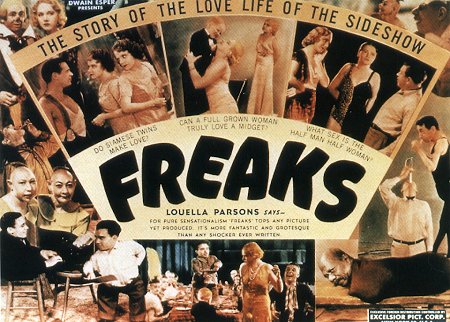
This guest post by Karina Wilson appears as part of our theme week on Cult Films and B Movies.
Cult movies are lightning in a bottle, a one-time only circumstance of story, director, cast, crew, location and budget that defies original intentions and transmutes into something unforgettable, unrepeatable, unsurpassable. Cult movies are accidental, born of a mismatch between the scenes filmmakers thought they were shooting, and what ended up in the can. Cult movies are magic, of a puckish sort, and we shouldn’t probe their mysteries too closely. They’re best regarded from a distance, after a significant amount of time has passed.
Freaks (1932) is a true cult movie, one that’s ridden a rollercoaster of opprobrium and acclaim since its initial release. Tod Browning’s sideshow-set horror-romance destroyed his career (and several others), caused such disgust in early audiences that one woman (allegedly) miscarried, outraged critics and moral guardians, traumatized some of the performers who appeared in it, languished in obscurity after being banned for three decades, resurfaced on the exploitation circuit in the 1960s, and earned a spot in the National Film Registry archives in 1994 before enjoying its current status as a one-of-a-kind classic. It’s been repeated to the point of cliché, but Freaks, once seen, is never forgotten. Love it or hate it, it will stay with you for the rest of your life.
Originally, Freaks wasn’t intended to achieve any of these feats. All MGM head honcho Irving Thalberg wanted was a box office hit, along the lines of Universal’s Dracula (1931), a movie that exploited the audience’s new-found appetite for the talking horror genre. So he called Tod Browning, Dracula‘s director, who’d had a run of success during the silent era working with Lon Chaney Sr., and asked the million-dollar question “What else have you got?”
Although “horror” wasn’t a label applied to film in the 1920s, Browning and Chaney’s collaborations dealt with mutilation, disfigurement, and the resulting heartbreak (see: The Phantom of the Opera and The Unknown), subjects dear to the hearts of those whose loved ones had returned home, scarred, from the war in France. Browning and Chaney had also worked together on box office sensation The Unholy Three, a macabre crime caper featuring the 3’ 3” tall circus performer, Harry Earles.
Earles enjoyed working in the movies but knew there weren’t many roles out there for actors his size. So he brought Browning’s attention to another short story by Unholy Three writer, Tod Robbins, Spurs, a mean little melodrama about a love triangle between a circus midget, a bareback rider, and her normal-sized lover. Browning had a carnival background (he ran away to join the circus when he was 16), loved the milieu, and, when MGM gave him carte blanche to direct a movie more horrifying than Dracula, he picked Freaks.
In those pre-television days, the circus sideshow ruled supreme as entertainment for the curious masses. Trumpeted as part edification, part education, the ‘Ten-In-One” tent showcased human oddities and provided a rare opportunity for those born with a difference to earn a living. People with all manner of abnormalities found a profitable home in the sideshow – armless, legless, eyeless, giant, dwarf, bearded, scaled, obese, skeletal. Some simply exhibited their unique bodies, others performed an act, introducing music, dance, stage magic or comedy into their routine; many earned good money and toured the globe. After auditioning the crème-de-la-crème of this international talent pool, Browning assembled his cast, the likes of which has never been seen on a movie screen before or since.
The cast of Freaks includes some bona fide female sideshow stars, women who projected glamorous images of considerable wattage despite being born different. They worked their way up through circuses and on the vaudeville circuit, often from a very early age. They viewed their divergence from the accepted norm as an opportunity to build a show business career, rather than as a debilitation. Self-sufficient, often with strings of admirers, they didn’t lead easy lives, but charted their own paths and lived to a respectable age. It’s difficult to imagine any of these performers working in the perfect-image-obsessed entertainment industry today.
Conjoined twins Daisy and Violet Hilton had been working professionally in vaudeville since the age of three. Renowned for their beauty, fashion sense and musicianship as well as their dancing skills (they performed onstage with Bob Hope and Charlie Chaplin), they had recently received $100,000 damages and emancipation from their predatory managers (they later said they were “paupers living in practical slavery”) and their appearance in Freaks marked the beginning of their independent career.
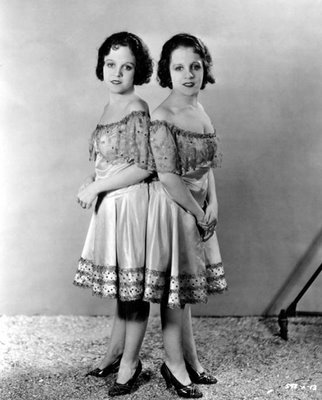
The “midget Mae West,” Daisy Earles (Frieda), along with her brother Harry and two equally short-statured sisters Tiny and Gracie, was part of the Doll Family, a popular act who toured with both the Ringling Brothers and Barnum and Bailey Circuses, and appeared in Laurel and Hardy films.
Martha Morris billed herself as “Martha The Armless Wonder” and was a featured attraction at Coney Island and in the traveling Freak City Show in the 1920s. She entertained rubes by writing and typing with her toes as dexterously as if they were fingers. Frances O’Connor’s stage name was “the Living Venus De Milo,” and she loved to pose in specially designed costumes that showed her entirely smooth and armless (there were not even stumps) torso, whilst impressing admirers with her coffee-drinking, cigarette-smoking and sharp-shooting skills.
By contrast, the non-“freak” women (Cleopatra, the Peacock Of The Air” trapeze artist, and Venus, the animal trainer) are low profile. Myrna Loy supposedly begged not to play Venus, and, although mentioned in press releases, Jean Harlow failed to materialize as Cleopatra. Instead, Russian defector Olga Baclanova (a gifted physical actor who was struggling with the shift to talkies) got the villainess role, while hard-working contract player Leila Hyams was cast as Venus. Both women were regular Hollywood blondes, used to commanding the silent screen with the arch of an eyebrow or the flare of a nostril, but, at 36 and 27 respectively, they were aging out of leading roles and Freaks marked the last major stop on the Hollywood Express for both of them.
Given the luminaries in the cast, it’s not surprising that Freaks is a female-driven narrative, a deft illustration of Madame de Merteuil’s assertion in Dangerous Liaisons, that “When one woman strikes at the heart of another, she seldom misses, and the wound is invariably fatal.” The plot is simple and universal: unrequited love, greed, jealousy, revenge.
The beautiful Cleopatra knows her co-worker, Hans, is in love with her, although she does not reciprocate the feeling. She enjoys making fun of him, much to the chagrin of his fiancée, Frieda. When Frieda lets slip that Hans has inherited a fortune, Cleopatra (egged on by her boyfriend, Hercules) persuades Hans to ditch Frieda and marry her. The other co-workers are suspicious of Cleopatra’s gold-digging motives but, if Hans is happy, they’re happy, and they all attend a celebratory wedding feast to welcome Cleopatra to the family. Unfortunately, Cleopatra sneers at their attempts to be friendly, and humiliates Hans, who collapses thanks to the alcohol she’s been forcing down him all evening – along with a dubious substance from a tiny black bottle. Frieda is furious. From that point on, Cleopatra is doomed. Frieda and the other co-workers close ranks around Hans to protect him from Cleopatra’s nefarious schemes and will do whatever it takes to keep him safe.
This is the type of run-of-the-mill romantic retribution played out every night of the week on today’s Lifetime network. We enjoy seeing the man-stealing hussy get her just desserts, while the wronged party is reunited with her one true love. In terms of pure plot, Freaks presents nothing we haven’t seen before. It creaks. It’s clumsy. It’s barely even a horror story. That’s the point. That’s why, 81 years later, Freaks still resonates as a progressive text. By rejecting fantasy, by refusing to use freaks to populate a fairy tale (as The Wizard of Oz would do seven years later), instead slotting them into a bog standard kitchen sink melodrama (albeit with a circus setting) Browning succeeds in making us see his characters as people first.
Much of Freaks’ power comes from the humdrum nature of the narrative, coupled with the easy familiarity of the early scenes. The first half of the screenplay deals with housekeeping, where the circus performers sleep (and who they sleep with), how they peg laundry out to dry, roll a cigarette, sip coffee, present a new baby to their friends. Dialogue takes the form of petty squabbles, between husband-to-be and conjoined fiancée, and performers discussing the mechanics of their acts. We’re forced to vacate our circus spectator headspace; there are no sequins or spotlights to direct our gaze. We quit gawking and embrace domesticity. It’s O.K. to be “one of us.”
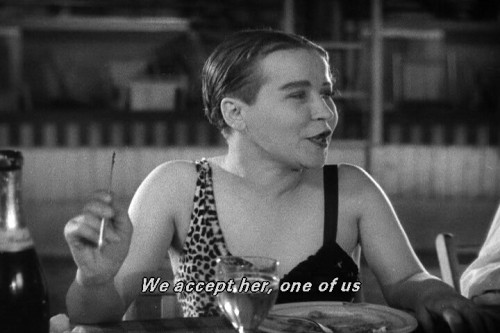
This makes the second half all the more disturbing. After breaking down their Otherness, establishing the freaks as friendly, ordinary beings, not at all threatening, pussycats in fact, Browning lets rip. These freaks – even infantilized pinheads like Zip and Pip – have teeth. Masterminded (we assume, although we never see her giving the orders) by the cherubic Frieda, the freaks enact justice. We’ve been encouraged to recognize their inner contentment and beauty. In the spirit of reciprocity, the freaks pull Cleopatra’s inner hideousness to the surface. Sideshow justice is done, and, within the movie’s running time of little over an hour, it’s all the more terrifying for its swiftness.
Freaks still makes for startling viewing, and, even in these enlightened, CGI-weary times, challenges our expectations of the human form. We’re so used to seeing physical perfection as the standard, so conditioned to accept the narrowest definition of beauty, so ignorant of the spectrum of human shapes, that many frames of the movie seem like a slap in the face. Freaks stands as a reminder that, for all our talk about diversity and inclusiveness, we sideline performers with difference. Unless they are playing “grateful recipient of charity” or “pathetic victim” or “awkward dependent,” we’ve largely wiped them from our screens.
Perhaps the most shocking thing about Freaks is that the diverse human beings in this pre-Production Code picture take it for granted that they can go about their business, flirt, have relationships, express sexual desire and procreate without any hand-wringing, or guilt, or “professional intervention” (a la The Sessions) from the normals. They invite us to gaze upon them, not with pity, but as players with agency in a story as old as time. Although it’s often criticized for being exploitative (and the critics have a point), Freaks is still the only movie in over a century of cinema history to celebrate these characters so boldly on the big screen. Until someone steps up to the plate, Freaks remains a unique experience, my cult classic, lightning in a fascinatingly misshapen bottle.
For more about the making of Freaks go to http://horrorfilmhistory.com/index.php?pageID=freaks.
Karina Wilson is a British writer and story consultant based in Los Angeles. She writes a regular column on horror fiction at Litreactor and can also be found at Horror Film History.
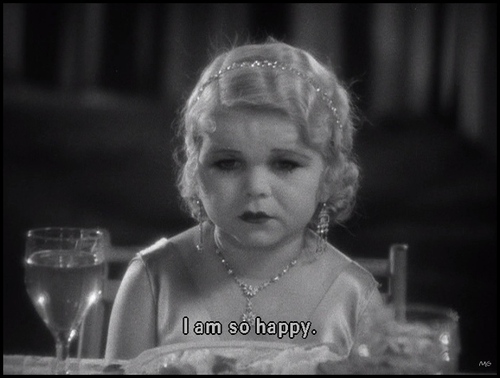
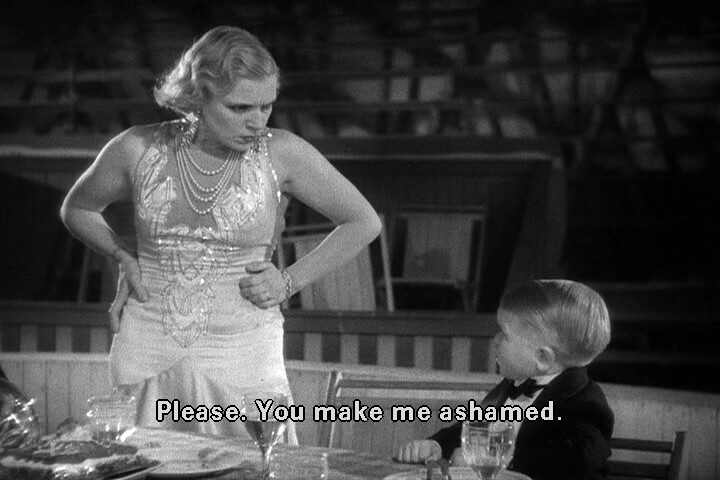
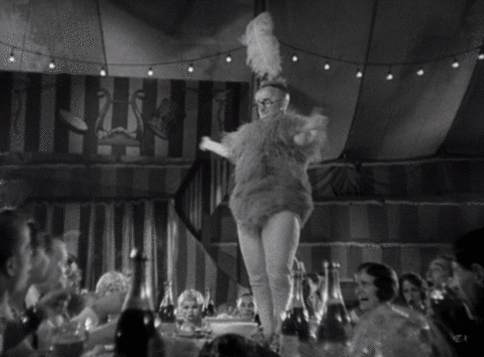
Wonderful piece, Karina. Thank you for writing this. Freaks had an enormous impact on me when I saw it as a teenager, and to this day remains one of the movies I’ve had the strongest visceral reaction to. Despite all its issues, I love it on an utterly pre-rational level, and you’ve done a terrific job of articulating why it can be so meaningful to those of us with non-normative bodies.